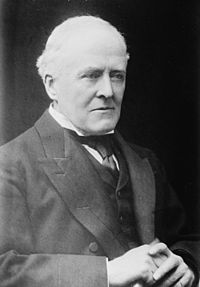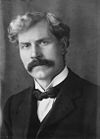- Charles Cripps, 1st Baron Parmoor
-
The Right Honourable
The Lord Parmoor
KCVO PC QC
Lord Parmoor in 1922 Lord President of the Council In office
22 January 1924 – 3 November 1924Monarch George V Prime Minister Ramsay MacDonald Preceded by The Marquess of Salisbury Succeeded by The Marquess Curzon of Kedleston In office
7 June 1929 – 24 August 1931Monarch George V Prime Minister Ramsay MacDonald Preceded by The Earl of Balfour Succeeded by Stanley Baldwin Leader of the House of Lords In office
7 June 1929 – 24 August 1931Monarch George V Prime Minister Ramsay MacDonald Preceded by The Marquess of Salisbury Succeeded by The Marquess of Reading Personal details Born 3 October 1852 Died 30 June 1941 Nationality British Political party Conservative
LabourSpouse(s) (1) Theresa Potter (d. 1893)
(2) Marian Ellis (d. 1952)Alma mater New College, Oxford  "Vicar General". Caricature by Spy published in Vanity Fair in 1902.
"Vicar General". Caricature by Spy published in Vanity Fair in 1902.
Charles Alfred Cripps, 1st Baron Parmoor KCVO, PC, QC (3 October 1852 – 30 June 1941) was a British politician who crossed the floor from the Conservative to the Labour Party and was a strong supporter of the League of Nations and of Church of England causes.
Contents
Family and early career
Cripps was the third son of Henry William Cripps, a wealthy Barrister and Queen's Counsel from Berkshire. He attended Winchester College and New College, Oxford, both on scholarships, and won four first classes at Oxford. At the end of his undergraduate years he was awarded a Fellowship at St John's College, Oxford, which he held for six years.
He was called to the Bar (Middle Temple) in 1877 and went into practice as a barrister. He became a Queen's Counsel in 1890 and a Bencher of the Middle Temple in 1893. He was appointed as Attorney-General to the Prince of Wales in 1895, a job he retained through two changes of Prince until 1914; his personal service to the Royal family was rewarded in 1908 with the KCVO.
Parliament
Cripps later claimed to have been a supporter of the Liberal Party, but in deference to his die-hard Conservative father, he declined to get involved in politics. However he sided with the Unionists over the issue of home rule for Ireland and was elected as a Unionist to Parliament for Stroud in 1895,[1] where he was a member of the South Africa Commission (investigating the Jameson Raid). He lost his seat in 1900, but soon returned in a by-election as MP for Stretford.[1]
As a devout Anglican of the High church tradition, Cripps was very active in Church affairs and was appointed Vicar-General of York in 1900 and of Canterbury in 1902. He again lost his seat in the Liberal landslide victory of 1906, but was elected for Wycombe (a constituency that included the family home) in 1910.[2] He received a peerage from the Liberal government in 1914 and took the title Baron Parmoor, of Frieth in the County of Buckingham,[3] from the family estate. Although not a judge, he was specially appointed to the Privy Council[4] and to its Judicial Committee, and during the Great War he headed a committee determining damages from German raids.
Great War
Parmoor considered that his elevation to the peerage in a semi-judicial role had removed any previous political affiliations. The war had a profound effect on Parmoor's political views, as he considered the decision to go to war a disaster. He opposed conscription and sympathised with conscientious objectors, who he thought were subject to excessive punishment. In the aftermath of war, he became very active in international causes, setting up the 'Fight the Famine Council' which had as its secondary objective the establishment of a League of Nations. The organisation was non-partisan but several trade unions and senior members of the Labour Party took part. When the National Church Assembly was established in 1920 to govern the Church of England, Parmoor was elected to the House of Laity and became its first Chairman.
Labour Party
Parmoor approved of the statement on peace in the Labour Party's 1923 election manifesto. After the election, with a Labour government in prospect, he received a letter from Ramsay Macdonald inviting him to join it. Parmoor wrote that he "should rejoice in the formation of a Labour Government under your leadership". He was made Lord President of the Council and joint Leader of the House of Lords with Viscount Haldane, with the difficult job of piloting government legislation through a House in which it had minimal support. Although the government lost practically every vote, Parmoor was able to persuade the opposition that they would lose support by wrecking the whole legislative programme. Macdonald, who was serving as his own Foreign Secretary, also chose Parmoor as British representative to the Council of the League of Nations, and to its Assembly in September 1924.
After the end of the Labour government, Parmoor remained active in the House of Lords, and when Haldane died in 1928, was elected Leader of the Labour Peers. He served again as Lord President of the Council with special responsibility for League of Nations affairs in the second Labour government of 1929–1931, despite his advanced age. He remained with the Labour Party when MacDonald formed the National Government in August 1931, disapproving of MacDonald's actions on constitutional grounds, but stepped down as Leader of the Labour Peers at the dissolution of Parliament on 7 October.
Family
Lord Parmoor married firstly Theresa, daughter of the Radical MP Richard Potter and sister of Beatrice Webb, in 1881. Of the four sons from the marriage, the eldest two, Alfred and Frederick, succeeded him to the peerage, and the youngest, Stafford, would become a prominent political figure in the 1930s and 1940s. Theresa died in 1893. In 1919, he married Marian, daughter of John Ellis. Lord Parmoor died in June 1941, aged 88. His second wife died in July 1952.[5]
References
- ^ a b leighrayment.com House of Commons: Stamford and Spalding to Stroud and Thornbury
- ^ leighrayment.com House of Commons: Witney to Wythenshawe and Sale East
- ^ London Gazette: no. 28794. p. 495. 20 January 1914.
- ^ London Gazette: no. 28795. p. 587. 23 January 1914.
- ^ thepeerage.com Charles Alfred Cripps, 1st Baron Parmoor
External links
- Hansard 1803–2005: contributions in Parliament by Charles Cripps
Parliament of the United Kingdom Preceded by
David Brynmor JonesMember of Parliament for Stroud
1895–1900Succeeded by
Charles Peter AllenPreceded by
Sir John William MaclureMember of Parliament for Stretford
1901–1906Succeeded by
Harry NuttallPreceded by
Thomas Arnold HerbertMember of Parliament for Wycombe
1910–1914Succeeded by
William Baring du PréPolitical offices Preceded by
The Marquess of SalisburyLord President of the Council
1924Succeeded by
The Marquess Curzon of KedlestonPreceded by
The Earl of BalfourLord President of the Council
1929–1931Succeeded by
Stanley BaldwinPreceded by
The Marquess of SalisburyLeader of the House of Lords
1929–1931Succeeded by
The Marquess of ReadingParty political offices Preceded by
The Viscount HaldaneLeader of the Labour Party in the House of Lords
1928–1931Succeeded by
The Lord Ponsonby of ShulbredePeerage of the United Kingdom New creation Baron Parmoor
1914–1941Succeeded by
Alfred Henry Seddon CrippsCategories:- 1852 births
- 1941 deaths
- Lord Presidents of the Council
- Members of the Privy Council of the United Kingdom
- Labour Party (UK) politicians
- Conservative Party (UK) MPs
- English Queen's Counsel
- Queen's Counsel 1901–2000
- Members of the United Kingdom Parliament for English constituencies
- Barons in the Peerage of the United Kingdom
- Knights Commander of the Royal Victorian Order
- Old Wykehamists
- Alumni of New College, Oxford
- Fellows of St John's College, Oxford
- English barristers
- UK MPs 1895–1900
- UK MPs 1900–1906
- UK MPs 1910–1918
- Members of the Middle Temple
- Leaders of the House of Lords
Wikimedia Foundation. 2010.

